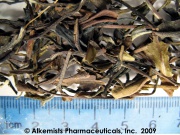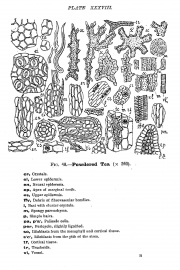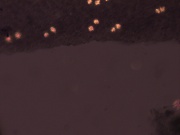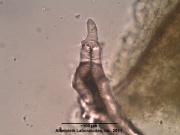|
|
| Line 46: |
Line 46: |
| | {{Microscopy | source=Elan M. Sudberg Alkemist Laboratories | | {{Microscopy | source=Elan M. Sudberg Alkemist Laboratories |
| | | mainimage=Alkemists_Camellia_sinensis_(L.)_Kuntze_-Theaceae-_irregular_and_branched_astrosclereid_from_the_leaf.jpg | | | mainimage=Alkemists_Camellia_sinensis_(L.)_Kuntze_-Theaceae-_irregular_and_branched_astrosclereid_from_the_leaf.jpg |
| | + | | caption1=Irregular and branched astrosclereid from Camellia sinensis leaf viewed at 400x with Acidified chloral Hydrate Soln. |
| | | companyimage=AP-LOGO-Laboratories Crop - Copy.jpg | | | companyimage=AP-LOGO-Laboratories Crop - Copy.jpg |
| | | description=Green Tea Leaf ("Camellia sinensis") | | | description=Green Tea Leaf ("Camellia sinensis") |
| − | | characteristics=Irregular and branched astrosclereid from Camellia sinensis leaf viewed at 400x with Acidified chloral Hydrate Soln. | + | | image2=Alkemists_Camellia_sinensis_(L.)_Kuntze_-Theaceae-_thick_walled_unicellular_trichome.jpg |
| − | | }}
| + | | caption2=Thick walled unicellular trichome viewed at 400x under polarized light with Acidified chloral Hydrate |
| − | | + | | characteristics= |
| − | {{Microscopy | source=Elan M. Sudberg Alkemists Labs.
| + | |
| − | | mainimage=Alkemists_Camellia_sinensis_(L.)_Kuntze_-Theaceae-_thick_walled_unicellular_trichome.jpg
| + | |
| − | | description=Green Tea Leaf ("Camellia sinensis") | + | |
| − | | companyimage=AP-LOGO-Laboratories Crop - Copy.jpg
| + | |
| − | | characteristics=Thick walled unicellular trichome viewed at 400x under polarized light with Acidified chloral Hydrate Soln.
| + | |
| | | }} | | | }} |
| | | | |
| | =HPTLC Entries= | | =HPTLC Entries= |
| | =Other Points of Interest= | | =Other Points of Interest= |
Revision as of 23:00, 4 September 2012
Introduction
Introduction from Wikipedia, the free encyclopedia (http://en.wikipedia.org/wiki/Camellia_sinensis, retrieved 02/20/2012).
Camellia sinensis is the species of plant whose leaves and leaf buds are used to produce Chinese tea. It is of the genus Camellia (Chinese: 茶花; pinyin: Cháhuā), a genus of flowering plants in the family Theaceae. White tea, green tea, oolong, pu-erh tea and black tea are all harvested from this species, but are processed differently to attain different levels of oxidation. Kukicha (twig tea) is also harvested from Camellia sinensis, but uses twigs and stems rather than leaves. Common names include tea plant, tea tree, and tea shrub.
There are two major varieties used for tea, Chinese tea, Camellia sinensis var. sinensis, and Assam tea, Camellia sinensis var. assamica.
The quoted text in this section was licensed for use under the Creative Commons ShareAlike License, version 3.0: http://creativecommons.org/licenses/by-sa/3.0/
Macroscopic Entries
| Green Tea Leaf ("Camellia sinensis")Macroscopic image of cut and sifted Camellia sinensis
Source: Elan M. Sudberg Alkemist Laboratories [1]
|
|

Green Tea Leaf ("Camellia sinensis")
|
|
Microscopic Entries
| Tea (leaves) (Camellia sinensis)The upper epidermis is composed of cells with undulating walls and covered with a rather thick cuticle. The lower epidermis consists of smaller cells and is alone provided with stomata; the latter are surrounded by three or four tangentially clongated cells.
Simple hairs occur on both surfaces of the leaf, but they are more abundant on the lower; the number, however, varies with the variety of tea, and with the age of the leaf; they are unicellular, tapering and rather thick walled, varying very much in length, but often attaining 500-700 microns.
The mesophyll is heterogeneous and asymmetrical. It is characterized by the presence of a large number of sclerenchymatous idioblasts. These are more or less branched and warty and often extend transversely from the upper to the lower epidermis. They vary much in shape and in the thickness of the walls. The cells of the spongy parenchyma contain cluster crystals of calcium oxalate.
The midrib is biconvex. Under each epidermis there is a layer of collenchyma of varying thickness. The wood is arched and the bast contains crystals of calcium oxalate. The meristele is surrounded by a pericycle consisting of slightly lignified cells arranged in circle. The cortical tissue contains idioblasts which are usually rather larger and more branched than those of the mesophyll.
The little fragments of the stems, which are often to be found in ordinary tea, have a slightly different structure. The wood in them forms a circle within which there is a pith containing branched idioblasts; these have comparatively thin, pitted walls.
The diagnostic characters of powdered tea are:---
- The characteristic hairs.
- The sclerenchymatous idioblasts, especially in petiole and midrib.
- The stomata surrounded by tangentially elongated cells.
- The calcium oxalate in cluster crystals.
Source: Greenish, H. et. al. (1908) An Anatomical Atlas of Vegetable Powders [2]
|
|
|
|
| Green Tea (Camellia sinensis)Twin calcium oxalate crystals, polarized. 200X glyercin : deionized water solution.
Source: Amy Brush Traditional Medicinals [3]
|
|
|
|
| Irregular and branched astrosclereid from Camellia sinensis leaf viewed at 400x with Acidified chloral Hydrate Soln.
Source: Elan M. Sudberg Alkemist Laboratories [4]
|
|
|
|
HPTLC Entries
Other Points of Interest
Cite error: <ref> tags exist, but no <references/> tag was found





